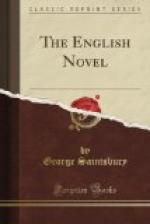careless and slovenly style is not much better:
for Scott had, perfectly, the style suited to his
own work, and you cannot easily have a better style
than that. But there are two defects in him which
were early detected by good and friendly judges:
and which are in fact natural results of the extraordinary
force and fertility of his creative power. One—the
less serious, but certainly to some extent a fault
in art and a point in which he is distinguished for
the worse from Shakespeare—is that he is
rather given to allow at first, to some of his personages,
an elaborateness and apparent emphasis of drawing
which seems to promise an importance for them in the
story that they never actually attain. Mike Lambourne
in
Kenilworth is a good example of this:
but there are many others. The fact evidently
was that, in the rush of the artist’s plastic
imagination, other figures rose and overpowered these.
It is an excuse: but it is hardly a justification.
The other and more serious is a tendency—which
grew on him and may no doubt have been encouraged by
the astonishing pecuniary rewards of his work—to
hurry his conclusions, to “huddle up the cards
and throw them into the bag,” as Lady Louisa
Stuart told him. There is one of the numerous,
but it would seem generic and classifiable, forms
of unpleasant dream in which the dreamer’s watch,
to his consternation, suddenly begins to send its
hands round at double and ten-fold speed. Scott
is rather apt to do this, towards the close of his
novels, in his eagerness to begin something else.
These defects, however, are defects much more from
the point of view of abstract criticism than from
that of the pleasure of the reader: while, even
from the former, they are outweighed many times by
merits. And as regards our present method of
estimation, they hardly count at all.
For, in that calculus, the important thing is that
Scott, like Miss Austen, at once opened an immense
new field to the novelist, and showed how that field
was to be cultivated. The complement-contrast
of the pair can need emphasising only to those on
whom no emphasis would be likely to impress it:
but it may not be quite so evident at once that between
them they cover almost the entire possible ground of
prose fiction. The more striking and popular
as well as more strictly novel style of Scott naturally
attracted most attention at first: indeed it can
hardly be said that, for the next thirty years, much
attempt was made to follow in Miss Austen’s
steps, while such attempts as were made were seldom
very good.[19] But there is no need to hurry Time:
and he generally knows what he is about. At any
rate he had, in and through these two provided—for
generations, probably for centuries, to come—patterns
and principles for whoso would to follow in prose
fiction.




